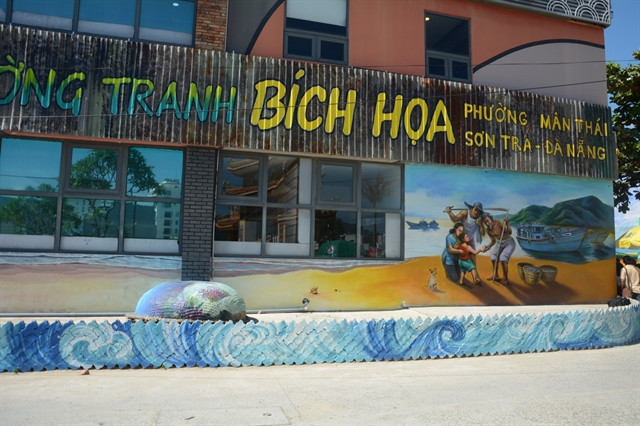 A painting decorates an old wall of a house in Man Thai Ward in Son Tra peninsula of Da Nang. Photo courtesy of Vo Dung
A painting decorates an old wall of a house in Man Thai Ward in Son Tra peninsula of Da Nang. Photo courtesy of Vo DungThe mural zone, which included 40 paintings on 400m of the old walls in analley of the coastal Tan An living quarter, was built as a check-in fortourists visiting the old fishing village as part of Son Tra peninsula tours.
In 2018, Da Nang included the preservation of ancient fishing villages of ManThai, Phuoc My and Tho Quang as part of eco-tour destinations, traditionalcultural performances, whale temples and crafts for tourism all ongoing in thevillages and surrounding area.
Now only five per cent of the population in the village still do fishing, whichis getting a boost from tourism.
Fishermen take short sea trips on coracles or use coastal fishing nets to makeextra money. The local fishermen's community still hosts the annual Le Hoi CauNgu (Whale Worshipping Festival) in lunar February and has done for the pastthree decades.
The festivals, which were organised by fishing communities in Son Tra, ThanhKhe, Ngu Hanh Son and Lien Chieu, were recognised as a National IntangibleHeritage in 2017.
Authorities of Son Tra district have also debuted its logo for tourism brands,with domestic and international promotion.
Son Tra peninsula district is home to a 4,400ha nature reserve, with 287species of animals and 985 species of plants.
A red-shanked douc langurs is snapped on Son Tra Nature Reserve in Da Nang.
The reserve, 10km from the city centre, shelters more than 1,300 red-shankeddouc langurs, declared endangered by the International Union for theConservation of Nature (IUCN) in 2013.
It is a favourite destination, with 10,000 tourists visiting the reserve everymonth. Da Nang approved the plan to protect biodiversity in Son Tra NatureReserve by 2030./.




























